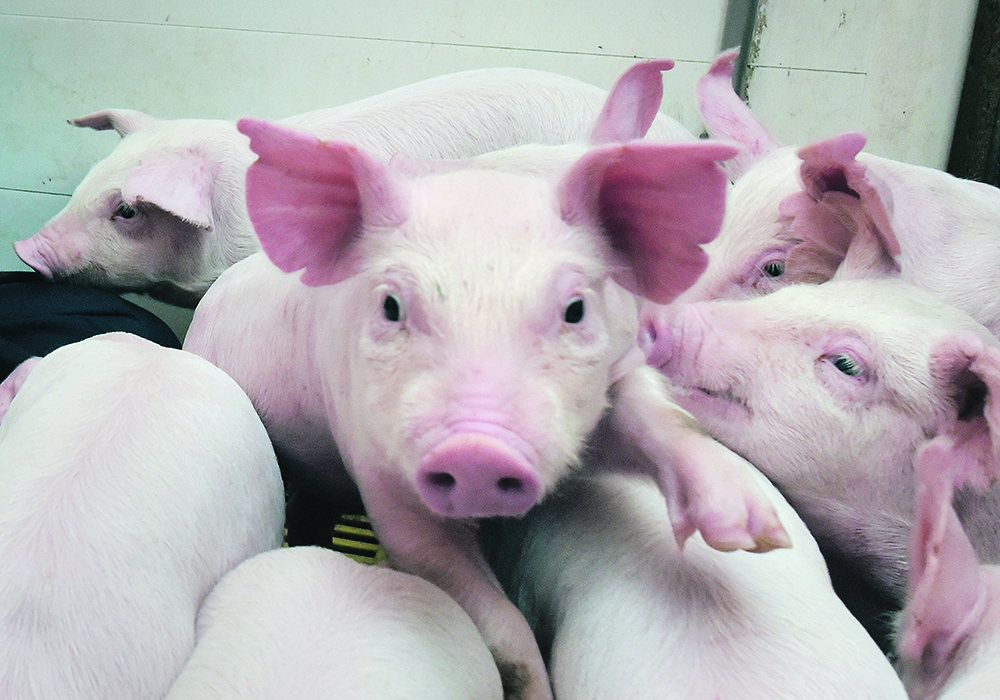Influenza has had a lot of attention over the past several months with a highly pathogenic avian flu strain causing health challenges in dairy herds in the United States.
While there have been other cattle influenza infections over the years, this is perhaps one of the more significant birds-to-bovine events.
In this article, we will discuss influenza in pigs and the challenges with managing this frustrating disease.
Read Also

The Western Producer Livestock Report – November 13, 2025
Western Producer Livestock Report for November 13, 2025. See U.S. & Canadian hog prices, Canadian bison & lamb market data and sales insights.
Fortunately, influenza in pigs does not impact food safety, but all influenzas pose a zoonotic risk for farm workers who work closely with animals.
Likewise, reverse zoonosis occurs when infected farm workers inadvertently infect their pig herds. The 1918 Spanish Flu epidemic saw pig herds around the world become infected with a human strain, which circulated as the dominant strain until the 1990s.
Flu viruses have a segmented genome, making it possible for one virus to trade segments of the genome with another strain. As a result, most swine strains in North America will have genome segments that were acquired from human strains. This is what is termed antigenic shift.
When actively replicating, flu viruses are also prone to replication errors (mutations), leading to strains that are subtly different than their “parent” strain. This process is termed antigenic drift.
Like many other species, pigs infected with influenza can exhibit acute respiratory disease with fever, inappetence, lethargy and of course coughing. While mortality is typically very low, once a farm becomes infected, up to 100 per cent of the population will become infected over time.
The economic impact of flu on pig farms is difficult to determine because there are often other viral pathogens at play as well as secondary bacterial infections contributing to overall losses.
The fever and inappetence lead to reduction in daily feed intake and therefore reduced growth for several days. Impact has been reported as high as $10.31 per pig.
In addition to the acute disease, flu is quite widespread in Canadian pig herds, leading to many herds with only partial immunity.
Suckling piglets that do not receive enough colostrum, or colostrum with the wrong flu antibodies due to viral drift, will become infected. The partial immunity allows for sub-clinical mild symptoms and continued virus circulation, making the disease difficult to manage.
Influenza does replicate in both the upper and lower respiratory tract. Diagnosis is generally straightforward with PCR testing (which detects the presence of pathogen genetic material) on lung tissue, nasal swabs or saliva samples.
Once we have a PCR positive result, the virus is categorized by the type of hemagglutinin (H) or neuraminidase (N) to determine the subtype of virus. For example, most swine influenza virus belong to the H1N1, H1N2 or H3N2 subtypes. In comparison, the highly pathogenic avian flu is a H5N1.
This basic analysis allows us to determine if the current circulating virus is consistent with previous farm isolations or has been a new introduction. Most strains are then genetically sequenced to be able to determine relatedness to other strains on the farm, neighbouring farms or regions.
No commercial flu vaccines are available for pigs, but veterinarians rely on custom vaccines that are manufactured based on the exact strain that has been found on the farm. These vaccines are called autogenous vaccines.
Two options are available for flu vaccines in Canada.
We can manufacture an mRNA vaccine (like the type used for COVID-19 vaccines that are available for people) matching the genetic sequence of the strain found on the farm.
The second option is a “killed-virus” autogenous vaccine that requires the farm strain to be grown on cell cultures in the laboratory and then manufactured into a vaccine.
It is quite common for two or more strains to be circulating on a farm at the same time, which puts the farm at risk of having antigenic “shift” occur. For that reason, we will often put more than one strain of flu into the vaccine to reduce the chance of uncontrolled virus continuing to replicate unchecked.
It is important that a farm continue to monitor and sample the herd when using flu vaccines to determine if a new strain enters the farm that is not in the vaccine, or if the farm’s strains have “drifted” and are genetically different from the original vaccine strain, resulting in insufficient immunity.
Like flu vaccinations in people, pig vaccines will not stop flu infection from occurring, but rather reduce symptoms and duration of illness and therefore reduce the economic impact on the farm.
Whether a farm is conventionally raising large groups of pigs, or a producer has a few pigs in their backyard, all caregivers need to consider wearing a mask if you have symptoms of human influenza, or better yet, stay away from the pigs until feeling better.
People working closely with pigs should receive their own flu vaccinations regularly and be in the habit of washing their hands frequently.
Blaine Tully is a veterinarian and owner of Swine Health Professionals Ltd. in Steinbach, Man.















